As an Amazon Associate CoffeeXplore.com earns from qualifying purchases.
Japandi Coffee Table: 9 Minimal & Modern Designs for a Zen Living Room
Are you struggling to find the perfect coffee table that blends seamlessly with your Japandi-style living room, providing both functionality and a calming aesthetic? Many find it challenging to incorporate furniture that reflects the minimalist and natural essence of Japandi design without sacrificing practicality.
To choose the perfect Japandi coffee table, consider a design that combines natural materials, clean lines, and a minimalist aesthetic, reflecting both Japanese and Scandinavian design principles. It should enhance the room’s zen atmosphere while providing functional value.
As a long-time interior design enthusiast with a particular passion for minimalist and functional spaces, I’ve spent years exploring the harmonious blend of Japanese and Scandinavian design, known as Japandi. This fusion creates serene, uncluttered environments, and selecting the right coffee table is crucial. In this guide, you’ll discover nine minimalist and modern Japandi coffee table designs, learn how to choose the perfect one for your space, and gain tips to maximize its aesthetic impact. Ready to transform your living room into a haven of tranquility? Let’s dive in!
Why Is Choosing the Right Coffee Table Essential for Japandi Living Rooms?
Choosing the ideal coffee table makes all the difference in a space. A well-selected Japandi coffee table will have a profound influence.
Impact on Space Flow and Functionality
The right coffee table helps to create a sense of calm and order, which is essential to the Japandi style. A carefully chosen coffee table can anchor the seating area, providing a surface for drinks, books, or decorative items, while maintaining an open and uncluttered flow. For example, a low-profile table helps preserve sightlines, making the room feel more spacious and airy.
Space Perception and Visual Balance
Japandi design emphasizes simplicity and natural elements. A coffee table that is too large or visually heavy can disrupt the balance. Conversely, a piece that’s too small might seem insignificant. The appropriate scale and design of the coffee table contribute to the overall visual harmony, enhancing the perception of a calm, well-proportioned space. Consider the Muji Round Oak Coffee Table. Its minimalist design and natural wood finish create an understated elegance that complements the Japandi aesthetic perfectly.
What Are 9 Minimal & Modern Japandi Coffee Table Designs for a Zen Living Room?
There are many styles of Japandi coffee tables. Here are some top choices:
1. Low-Profile Wooden Coffee Table
A low-profile wooden coffee table perfectly embodies the Japandi aesthetic, blending minimalist design with natural warmth. This design promotes a sense of groundedness and simplicity.
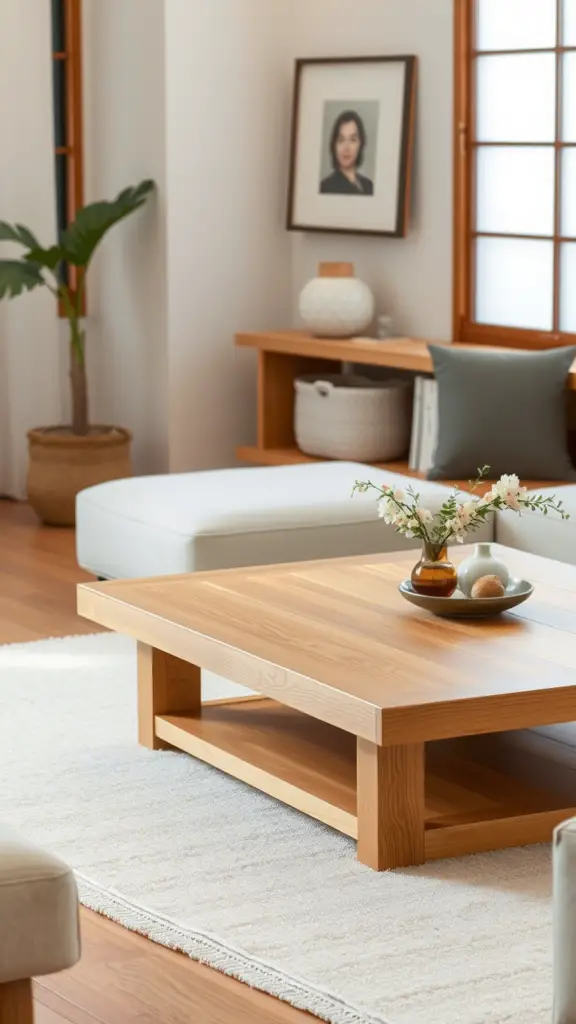
The low height encourages a closer connection to the floor, a common element in Japanese interiors, while the natural wood adds warmth and texture, characteristic of Scandinavian design. Key Takeaway: A low-profile wooden coffee table enhances the connection to nature and promotes a grounded, calming atmosphere. Consider something like the West Elm Mid-Century Art Display Coffee Table.
2. Round Coffee Table with Tapered Legs
A round coffee table with tapered legs offers a soft, organic shape that contrasts beautifully with the straight lines often found in Japandi design. It brings gentle curves.
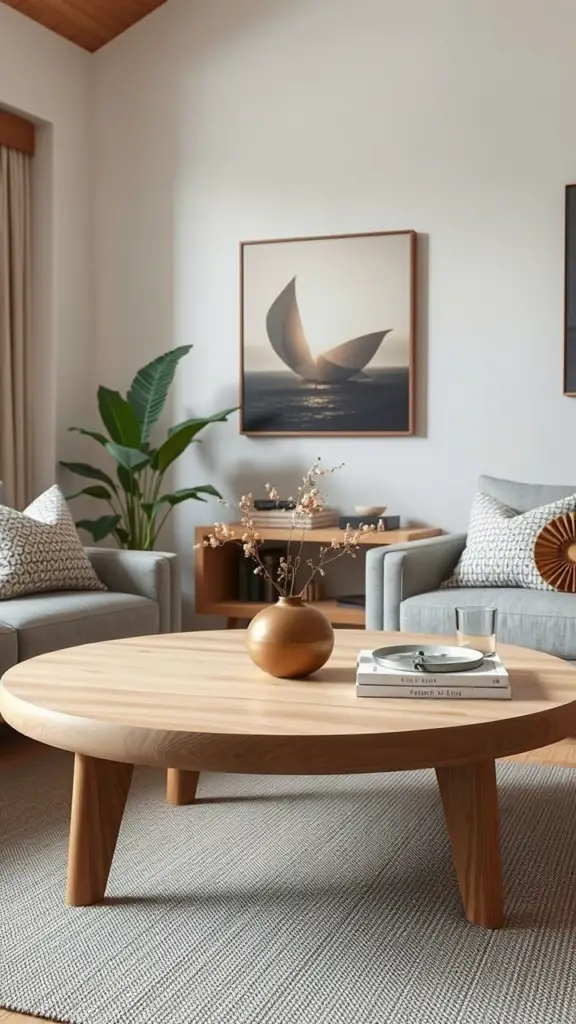
The rounded edges create a sense of flow and ease, making the space feel more inviting and less rigid. Tapered legs add a touch of mid-century modern flair, which complements both the Japanese and Scandinavian influences. Tip: Opt for a light-colored wood to keep the space feeling airy and bright.
3. Rectangular Coffee Table with Storage
A rectangular coffee table with built-in storage provides both form and function, essential elements of Japandi style. The added storage promotes organization and keeps the space calm.
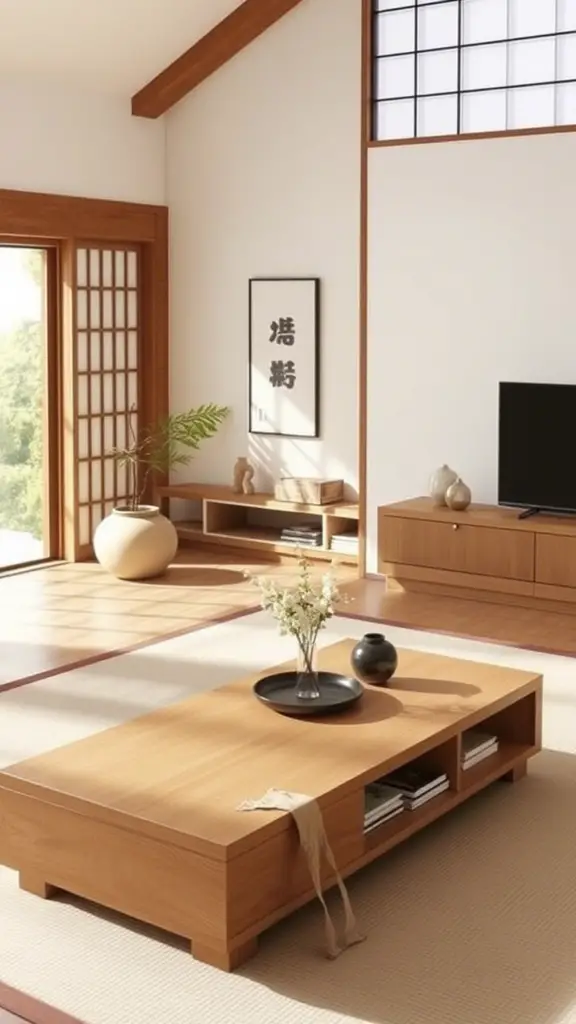
This design is perfect for keeping living rooms tidy, offering space to store remotes, magazines, or other essentials. The clean, rectangular shape aligns with the minimalist aesthetic, while the natural materials, such as wood or bamboo, add warmth. Key Takeaway: Integrating storage helps maintain a clutter-free environment, enhancing the sense of tranquility.
4. Black Stained Wood Coffee Table
A black-stained wood coffee table introduces a bold, yet understated element to a Japandi-inspired space, adding depth and contrast. It adds a stark, yet natural contrast.
While Japandi design often features light, natural tones, the addition of black provides a grounding element, reminiscent of traditional Japanese shou sugi ban (charred wood) techniques. The black finish highlights the wood grain, adding texture and visual interest. Tip: Pair it with lighter-colored furnishings and textiles to maintain balance.
5. Live Edge Coffee Table
A live edge coffee table brings a unique, organic touch to the Japandi aesthetic, celebrating the natural beauty of wood. The organic edge showcases nature’s artistry.
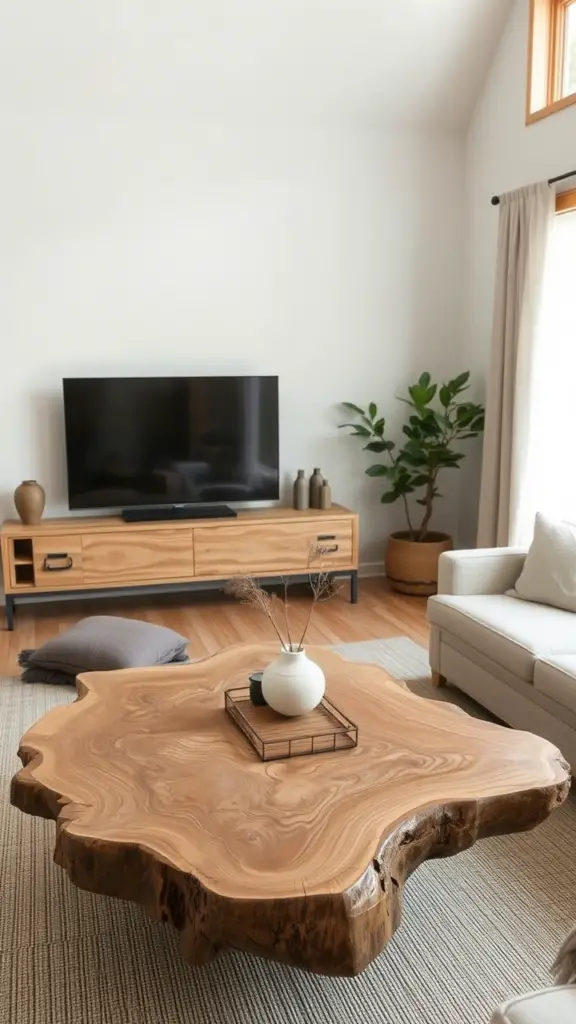
Each live edge table is one-of-a-kind, with the natural contours of the wood creating a striking focal point. This design element introduces a rustic touch, contrasting beautifully with the clean lines and simplicity of Japandi style. Key Takeaway: A live edge coffee table serves as a natural art piece, adding character and warmth to the room.
6. Glass Top Coffee Table with Wooden Base
A glass top coffee table with a wooden base combines the airy transparency of glass with the warmth of wood, creating a balanced and open feel. The mix of materials enhance openness and warmth.
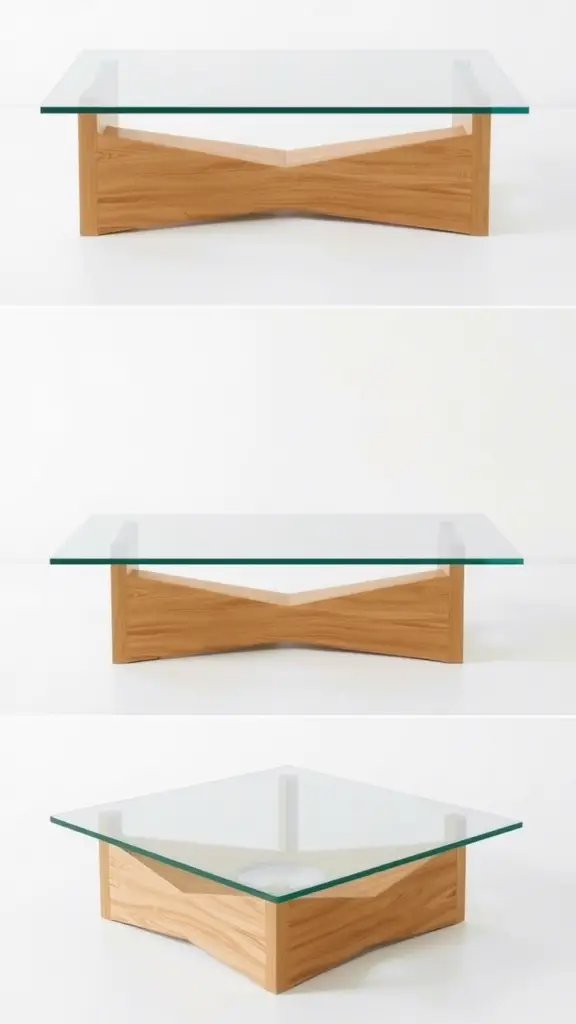
The glass top allows light to pass through, making the space feel brighter and more spacious. The wooden base provides a grounding element, anchoring the piece within the room. This combination reflects the Japandi principle of blending natural materials with minimalist design.
7. Nesting Coffee Tables
Nesting coffee tables offer flexibility and functionality, perfect for adapting to different needs and spaces. They provide flexible surface space.
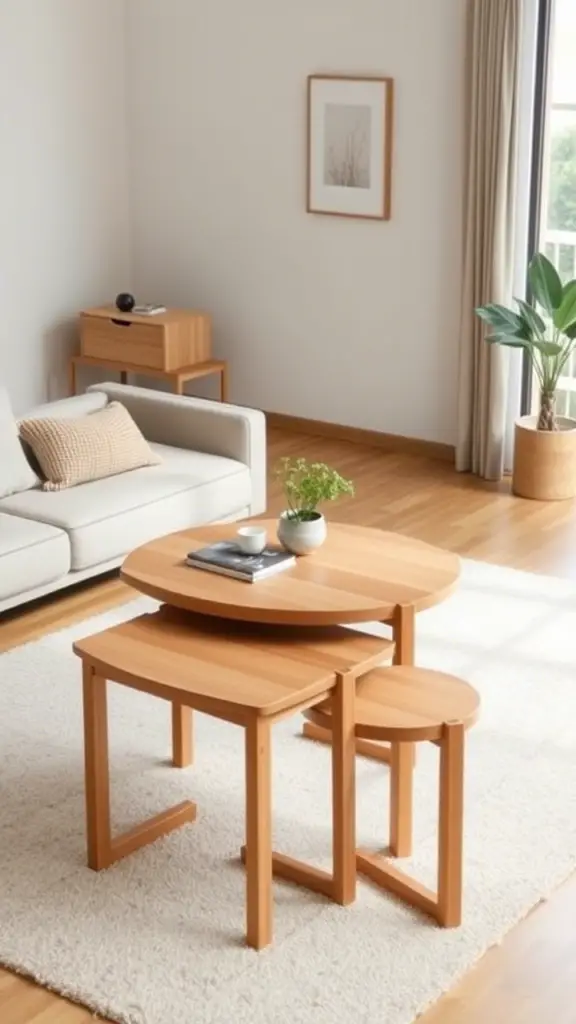
These tables can be arranged together for a layered look or separated to provide additional surface area when needed. Their compact design makes them ideal for smaller living rooms, and their versatility aligns with the Japandi emphasis on practicality. Tip: Choose nesting tables with a simple design and natural finish to maintain the minimalist aesthetic.
8. Stone or Concrete Coffee Table
A stone or concrete coffee table introduces a robust, earthy element to the Japandi style, contrasting beautifully with softer textures. It offers an earthy, robust element.
These materials add a sense of permanence and grounding, while their cool tones complement the warm wood and natural textiles often found in Japandi interiors. The minimalist design of a stone or concrete table ensures it remains understated yet impactful. Key Takeaway: Stone or concrete adds a touch of industrial chic while maintaining a connection to nature.
9. Oval Coffee Table
An oval coffee table combines the soft curves of a round table with the practicality of a rectangular shape, offering a balanced and functional design. This combines softness and functionality.
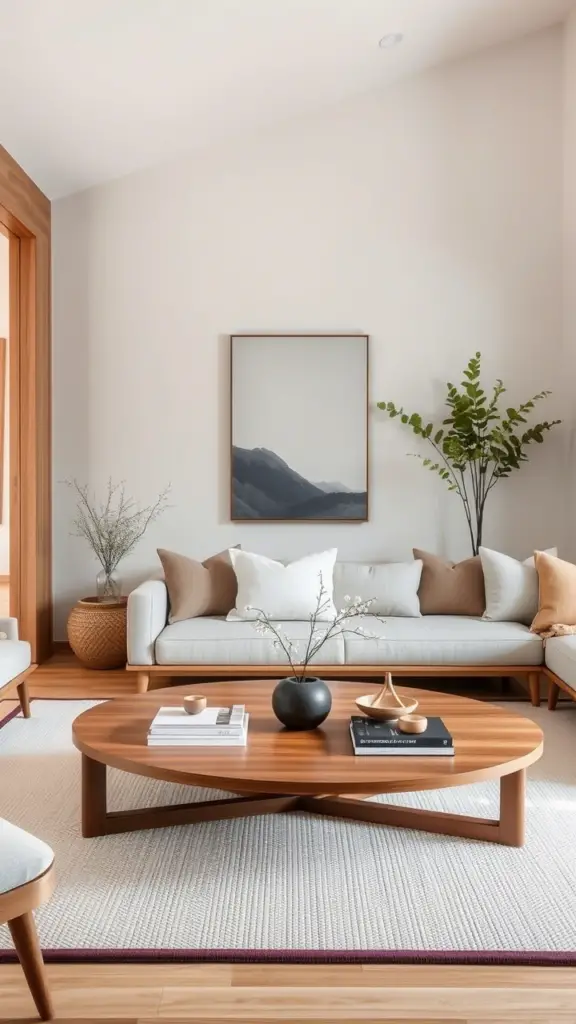
The elongated shape provides ample surface area while maintaining a gentle, flowing form. This design choice enhances the sense of harmony and ease in the living space, aligning with the Japandi aesthetic. Tip: Opt for a light-colored wood or a neutral finish to keep the space feeling serene and open. The Article Mara Oak Coffee Table has a similar vibe.
How Do You Choose the Perfect Size and Shape for Your Japandi Living Room?
Selecting the right size coffee table makes a significant difference in aesthetics. A well-proportioned coffee table will enhance the space.
Measuring and Space Planning
Begin by measuring your seating area. The coffee table should be approximately two-thirds the length of your sofa. Allow 14-18 inches of space between the coffee table and seating to ensure comfortable movement. This spacing helps maintain a balanced and functional layout.
Proportion Guidelines
The height of the coffee table should be roughly the same as, or slightly lower than, the height of your sofa’s seat cushions. This creates a cohesive and visually pleasing arrangement. For a standard sofa, a coffee table height of 16-18 inches is generally ideal. For a lower sofa, a coffee table around 12-16 inches high may be more appropriate.
What Materials Work Best for Japandi Coffee Tables?
Choosing materials helps to reinforce style and durability. Certain materials are more fitting for Japandi.
Light-Enhancing Materials
Light-colored woods like oak, ash, and beech are excellent choices for Japandi coffee tables. These woods reflect light, making the room feel brighter and more spacious. Glass tops also enhance light, creating an airy feel. Combining these materials can create a balanced and harmonious look.
Durability Considerations
Japandi design emphasizes longevity and quality. Solid wood is a durable option that ages beautifully, developing a rich patina over time. Stone and concrete are also highly durable and offer a unique, tactile quality. Ensure the materials you choose are not only aesthetically pleasing but also built to last.
FAQs About Coffee Table Japandi
What is the ideal coffee table height for a Japandi living room?
The ideal height is typically 1-2 inches lower than your sofa’s seat cushions, usually around 16-18 inches.
Can you mix different wood tones in a Japandi space?
Yes, mixing light and medium wood tones can add depth, but ensure they complement each other and maintain a cohesive look.
How much space should you leave around a Japandi coffee table?
Aim for 14-18 inches of clearance between the coffee table and other furniture for comfortable movement.
What shapes are best for creating a zen atmosphere?
Round and oval shapes promote a sense of flow and harmony, ideal for a zen-like Japandi space.
How can you style a Japandi coffee table without cluttering it?
Choose a few essential items, such as a minimalist vase, a stack of books, or a small tray, to maintain a clean and uncluttered look.
Summary:
Choosing the right Japandi coffee table involves balancing minimalist design with natural elements. Whether you opt for a low-profile wooden table, a live edge piece, or a design with storage, the key is to maintain a sense of simplicity and harmony. By considering the size, shape, and materials, you can create a serene and functional living space that embodies the Japandi aesthetic. Are you ready to embrace the tranquility of Japandi design in your home?

